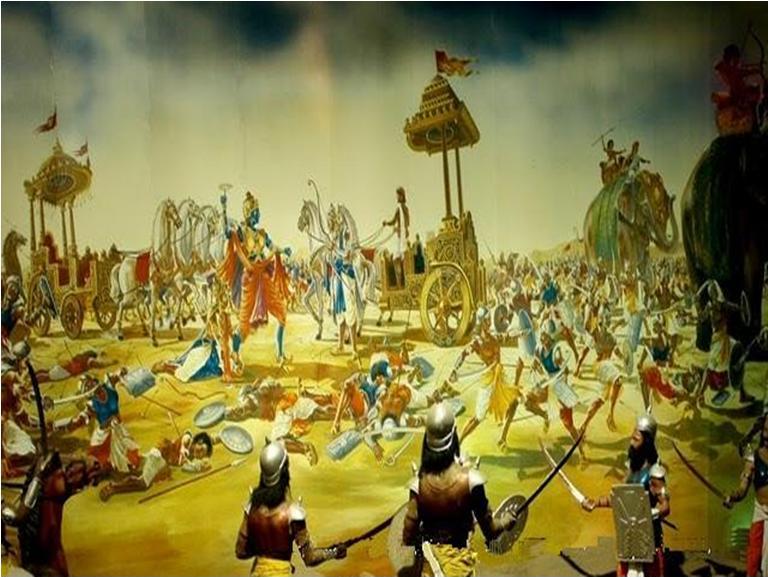Parvasangraha upa parva is the second upa parva of the first parva called Adi parva in the epic Mahabharat. There is a major difference between the parvasangraha upa parva with other upa parvas. The collection of the special heroic events of the Mahabharat characters, with emphasis on collection of arms, weapons had been narrated in this upa parva. Also, the collection and counting of verses of each and every chapter is narrated in this upa parva. The Upakhyanas were also collected and briefed in this upa parva. Upakhyanas were narrated as similar supporting stories but made crazier than the main story. The main story had gathered its volume with these side one proving stories, say upakhyanas and the central holiness was maintained with its credentials, like a holy religious book. Gandhiji had already declared Mahabharat as the fifth veda, or Panchamaveda.

Suta was the epic narrator. The holy sages, Shaunaka and his companions at Naimisharanya were the audience. Then Suta had addressed them. He continued the parvasangraha upaparva narrations as follows.
In the juncture period of Treta yuga prior to the birth of God Rama, the God had took his incarnation as Parasurama, as the son of sage Jamadagni. Parasurama had circumscribed the earth for twenty one times, holding an axe in his hand as his weapon. His main purpose of marching was to search for the erring kings and to slay off their heads. People should be allowed to live with good morality called Dharma, and few kings found in the same practice were allowed to continue to rule further with his blessings.
There were five natural tanks and after the war operations of Parasurama, these five tanks were found filled with blood of the slain kings. The place was very near to the Hastinapura. Later, the excellent period of one yuga had elapsed with the incarnation of Rama and his elevation into Vishnu loka. After that, at the end of Dwapara yuga, the very same place of five tanks was called as Kurukshetra. In this place, the Mahabharat war had been fought between Kauravas and Pandavas. Eighteen Akshohini armies had been engaged in the war but only three persons from the side of Kauravas had remained alive. In the war, Pandavas got victory but there was massive bloodshed, the quantum equivalent to fill up the Samantha Panchaka, the five tanks as mentioned above.
In the Parva sangraha, the arrangements of armies had been narrated. Akshohini was the unit of count of the soldiers, with elephants, horses and chariots drawn by horses. The collection of arrays of horses stood in the front, followed by chariots. The soldiers and weapons were carried by chariots from their respective palaces up to the army camps. The war ground resembled a big market fair land but the charging of violence had strict war protocols. People with no war dress code or weapons were kept away from the battle filed. Elephants were slow and the commanders used to sit on the elephants. Even though elephants failed or got killed, the commanders were able to maintain self-defense in the war.
पुण्यश्लोको नलो राजा पुण्यश्लोको युधिष्टिरः । पुण्यश्लोका च वैदेही पुण्यश्लोको जनार्दनः ॥ कार्कोटकस्य नागस्य दमयंत्या नलस्य च । ऋतुपर्णस्य राजर्षेः कीर्तनं कलिनाशनम् ॥
Meaning: The verses of king Nala are virtuous. The verses of king Yudhishtira are virtuous. The verses of queen Vaidehi too are virtuous. The verses of Janardhana are virtuous. The sins are washed away by reciting repeatedly the verses explaining of the serpent Karkotaka, and the name of of Damayanthi and also of her husband, Nala and of Rituparna the Rajarshi.
The hearing or reading of Mahabharat epic would bestow virtues up on the hearer or reader. It would wash away the sins of the reader and make him eligible for higher level of happiness.
In other words, the parva sangraha reader would acquire the traditional benefits of the virtues. The word meaning of sangraha is collection. The collections of verses of special events are emphasized in this upaparva. The purpose of the author, Veda Vyasa in the task of collections was nothing but provision of virtues and eliminating sins. Thus, the reading or hearing of Mahabharat epic is a basket to get virtues.
Various authors had completed their compilations of Mahabharat. Different persons had used different techniques to make the epic holier. Thus the one lakh Sanskrit verses had got either bulged or shortened.
In the old days, scripts were written on the palm leaves. The book bundles should be preserved and patronized inside the palaces of the king of any countries. The volume of the book bundles required a spacious room. Gurukula system of education had forced to preserve some of the books near the residence of the teacher. Paper bound books or palm leaves got damaged by ants or termites in due course of time. In the later compilations, in trying to make it complete, the authors had given importance to the essence of the storiess rather than the count of verses.
Here in gomangala.com, the compilation of the chapters of Mahabharat would be mainly providing bilateral benefits. The reading or hearing of Mahabharat should provide the reader virtues and eliminate the previous sins. Also, after getting some knowledge regarding the life of the important characters, important events, holy places within India, that one could come across in the Mahabharat, it automatically causes a change, or is a turning point of time, in guiding to lead the life towards the prosperity.
The total books are eighteen and the total sub chapters are one hundreds.
The total verses in Mahabharat would be more than one lakhs as written by Vyasa.
The life of Krishna is narrated in Bhagavatha but in some compilations, appear as an addendum to Mahabharat, the end chapters called Khila. Anyhow, Krishna was the incarnation of God. Krishna had managed the entire Mahabharat as a tool to kill the wrong doers and to protect the Dharma followers.
It is humbly prayed for the blessings of God Krishna upon us.
Next post, Mahabharat King Poushya may not be missed.
Chyavana in Mahabharat would be presented separately in another article.

Leave a Reply